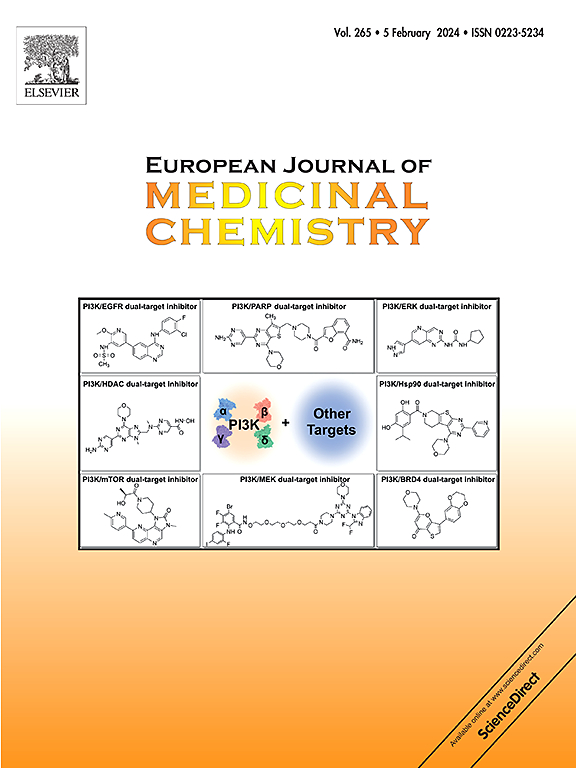Effect of stereochemistry at position C20 on the antiproliferative activity and selectivity of N-acylated derivatives of salinomycin
IF 6
2区 医学
Q1 CHEMISTRY, MEDICINAL
引用次数: 0
Abstract
Salinomycin (SAL), a natural polyether ionophore, exhibits a broad spectrum of pharmacological activities, including potent anticancer activity. Over the past decade, much effort has been put into developing methods for rational chemical modification of SAL to obtain semisynthetic analogs with higher anticancer activity than the native structure. In this paper, we describe an optimized procedure for synthesizing C20-aminosalinomycin 2 with native stereochemistry at position C20, which was confirmed by single-crystal X-ray diffraction analysis. We further transformed amine precursor 2 into a series of 48 C20–N-(thio)acylated products, including N-(sulfon)amides, N-(thio)ureas, and N-carbamates (urethanes), along with their sulfur analogs, i.e., S-substituted thiocarbamates and dithiocarbamates. This previously unreported class of derivatives showed superior cytotoxicity mostly in the nano- and subnanomolar concentration range and improved selectivity toward human cancer cells compared to those of chemically unmodified SAL and a commonly used oncological drug cisplatin. Of note, the obtained products inhibited the proliferation of reference cancer cells more effectively than their C20-epi-N-acylated counterparts, pointing out the pivotal role of stereochemistry at position C20. Our findings support the premise that the modification of SAL is a fruitful strategy for products with promising biological activity profiles. Moreover, the straightforward protocols should be of significant value for more elaborate modifications of SAL in the future.


C20 位立体化学对盐霉素 N-酰化衍生物抗增殖活性和选择性的影响
盐霉素(Salinomycin, SAL)是一种天然聚醚离子载体,具有广泛的药理活性,包括有效的抗癌活性。在过去的十年里,人们一直在努力开发对SAL进行合理化学修饰的方法,以获得比天然结构具有更高抗癌活性的半合成类似物。本文通过单晶x射线衍射分析证实了C20-氨基盐霉素2的天然立体化学反应,并对C20-氨基盐霉素2的合成工艺进行了优化。我们进一步将胺前体2转化为一系列48种C20-N-(硫)酰化产物,包括N-(硫)酰胺、N-(硫)脲和N-氨基甲酸酯(氨基甲酸酯),以及它们的硫类似物,即s取代的硫代氨基甲酸酯和二硫代氨基甲酸酯。与未经化学修饰的SAL和常用的肿瘤药物顺铂相比,这类以前未报道的衍生物在纳米和亚纳摩尔浓度范围内显示出优越的细胞毒性,并且对人类癌细胞具有更好的选择性。值得注意的是,获得的产物比C20-epi- n -酰化的对照癌细胞更有效地抑制了对照癌细胞的增殖,这表明C20位置的立体化学作用至关重要。我们的研究结果支持这样一个前提,即SAL的修饰是一种富有成效的策略,可以获得具有良好生物活性的产品。此外,这些简单的协议对于将来对SAL进行更详细的修改具有重要的价值。
本文章由计算机程序翻译,如有差异,请以英文原文为准。
求助全文
约1分钟内获得全文
求助全文
来源期刊
CiteScore
11.70
自引率
9.00%
发文量
863
审稿时长
29 days
期刊介绍:
The European Journal of Medicinal Chemistry is a global journal that publishes studies on all aspects of medicinal chemistry. It provides a medium for publication of original papers and also welcomes critical review papers.
A typical paper would report on the organic synthesis, characterization and pharmacological evaluation of compounds. Other topics of interest are drug design, QSAR, molecular modeling, drug-receptor interactions, molecular aspects of drug metabolism, prodrug synthesis and drug targeting. The journal expects manuscripts to present the rational for a study, provide insight into the design of compounds or understanding of mechanism, or clarify the targets.

 求助内容:
求助内容: 应助结果提醒方式:
应助结果提醒方式:


